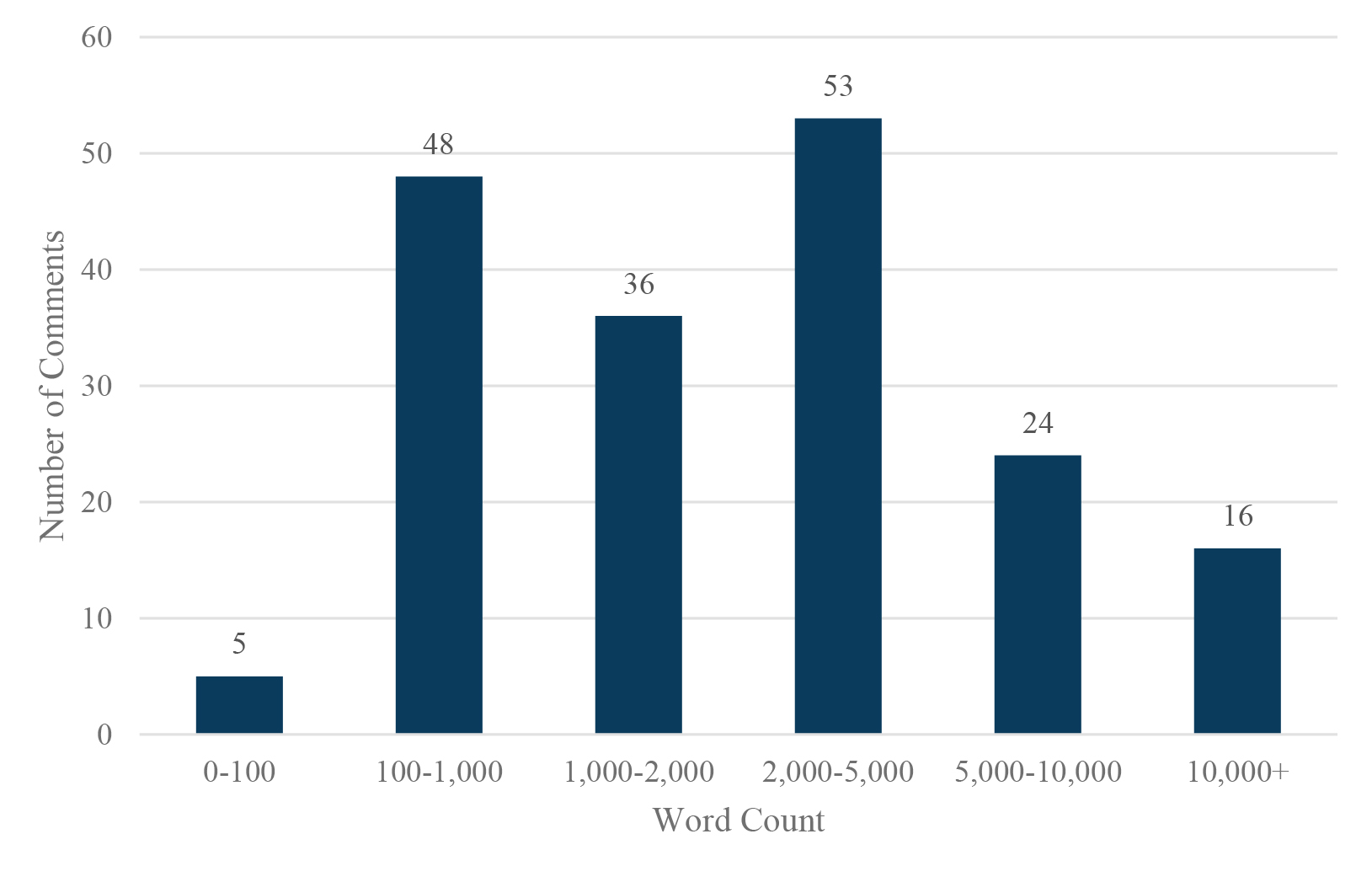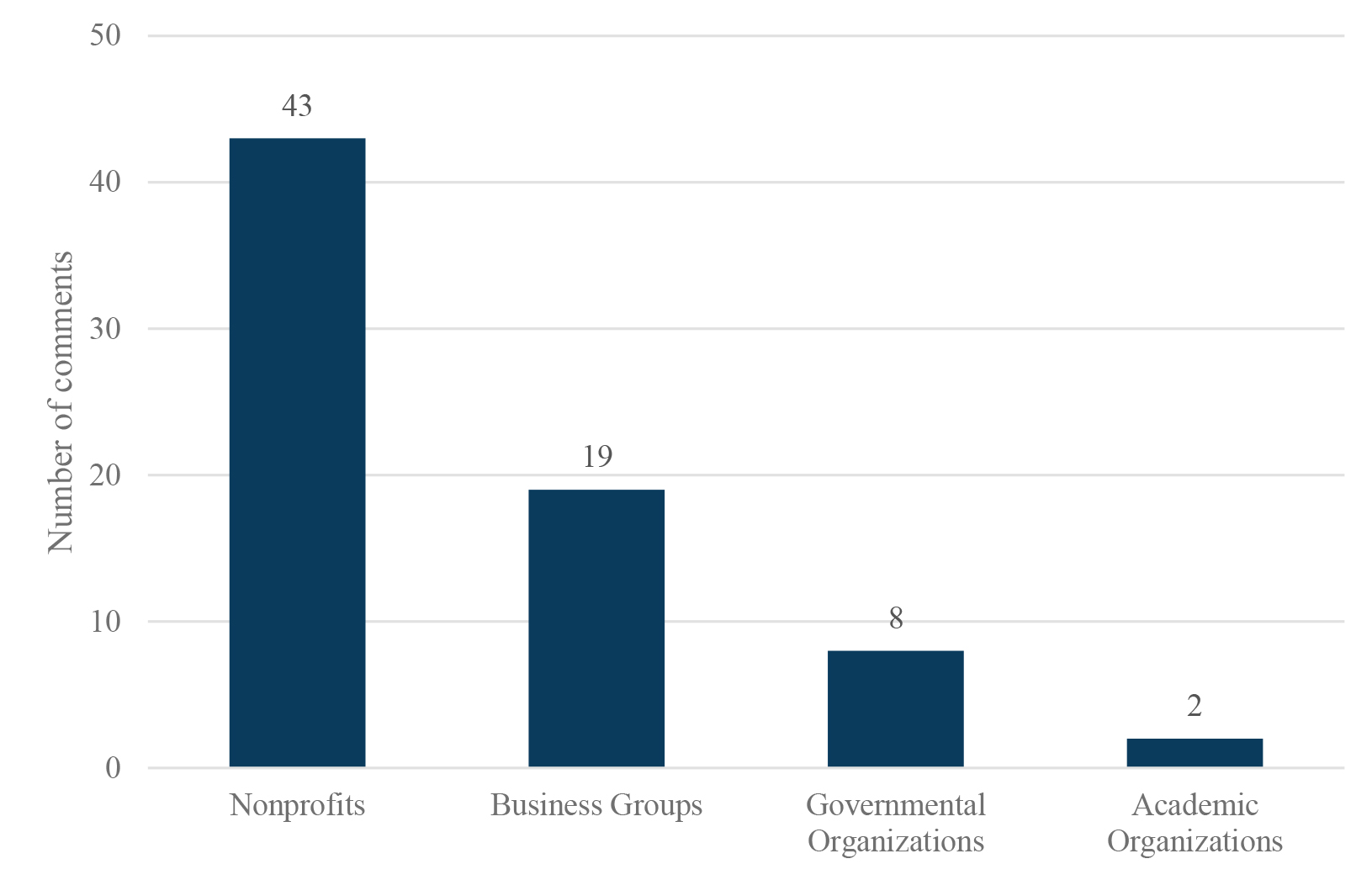Download this commentary (PDF)
In brief ...
OMB received nearly 4,500 public comments on the proposed revisions to Circular A-4. This commentary gives an overview of those comments and presents our findings on what topics they discuss and who commented based on text analysis of the unique comments.
Introduction
In April 2023, the Office of Management and Budget (OMB) released proposed revisions to Circular A-4, the federal government’s guidance on conducting regulatory impact analysis. The revised Circular A-4 is part of the Biden administration’s efforts to “modernize regulatory review.” Between April 7 and June 20, OMB received nearly 4,500 public comments on the proposed revisions to Circular A-4, of which fewer than 200 are unique. In this commentary, we give an overview of those comments and present our findings on what topics they discuss and who commented based on text analysis of the unique comments.
How Many Comments Are There?
OMB received 4,494 comments on the draft Circular A-4 in total. The vast majority of those comments are likely to be part of mass comment campaigns (MCCs), as they share identical or nearly identical content and templates. Among the others, 185 are unique comments with substantive content, of which 182 comments are available on Regulations.gov.
The MCC comments are generally supportive of the proposed changes and encourage increased inclusion, equity, and transparency in the regulatory process. For example, this comment utilizes an MCC-style template. One theme they express is that benefit-cost analysis is “an outdated and anti-public” mechanism that weights costs more heavily than unquantifiable benefits and supports the emphasis on unquantifiable benefits in the proposed revisions. The comments also strongly support the proposed changes to distributional analysis.
Since MCC comments generally express preferences in favor of or against the proposal instead of providing substantive information, we focus our analysis on the 182 available unique comments.
What Do They Discuss?
Of the 182 unique comments, 159 comments were submitted with at least one attachment, in addition to the content submitted as text; 11 comments contain two or more attachments; and two comments include three attachments. The comments have an average word count of 4,572, with a median of 2,036. The vast majority (166 comments) are moderate in length, containing less than 10,000 words (Figure 1).
Figure 1: Number of Unique Comments by Word Count
Topics in the proposed revisions to Circular A-4 that attracted the most attention include discount rates, distributional analysis, behavioral biases, and geographic scope. We analyze the unique comments to identify whether a comment discusses any of those four topics.
Specifically, we first develop a dictionary of key words and terms for each topic. For example, the topic of discount rates includes terms like “discount rate,” “social rate of time preference,” “consumer price index,” and “shadow price.” The full list of terms is available in Table 1. Using computational text analysis techniques, we then search the terms through all the unique comments to identify whether and how many times a comment mentions each term.[1] If a comment mentions one or more terms related to a topic, we classify the comment as containing some content that discusses the topic.
The results are unsurprising (Table 1). Of the 182 comments, 122 discuss discount rates, one of the most controversial topics in the draft Circular. In addition to the general terms (e.g., “discount rate” and “discounting”), “shadow price,” “rate of return,” and “Ramsey” are the most frequent phrases mentioned in the comments. Distributional analysis appears in 118 comments. In particular, the term “weight” (including its variants) is the most frequent term in the comments that discuss distributional analysis, indicating a focus of attention on distributional weights proposed in the draft Circular. One third (63) of the unique comments discuss geographic scope, a topic pertaining to whether and how agencies should consider the international effects of regulations. A small number of comments (24) discuss behavioral biases. The word counts and topics of all the unique comments are available in the Appendix.
Table 1: Topics and Key Terms in the Unique Comments
| Topic | Number of Relevant Comments | Occurrences of Terms * |
|---|---|---|
| Discount Rates | 122 | “discount rate”: 2348, “discount”: 967, “shadow price”: 185, “rate of return”: 182, “ramsey”: 182, “social rate of time preference”: 123, “intergenerational”: 122, “cpi”: 52, “return on capital”: 17, “consumer price index”: 14 |
| Distributional Analysis | 118 | “weight”: 1129, “distributional analysis”: 335, “marginal utility”: 280, “distributional effect”: 187, “income group”: 87, “demographic”: 47, “constant elasticity”: 10, “income class”: 6 |
| Geographic Scope | 63 | “citizen”: 234, “geographic scope”: 59, “noncitizen”: 56, “reside abroad”: 39, “foreign effect”: 6 |
| Behavioral Biases | 24 | “behavioral bias”: 141, “decision make bias”: 13, “heuristic”: 10, “rational preference”: 3 |
* Number of occurrences of each term across all the unique comments.
It is not rare for comments to discuss more than one of these topics. Nearly 60 percent (105) of the unique comments contain terms related to two or more topics, and 12 comments discuss all four topics. In particular, 92 comments cover both discount rates and distributional analysis.
Who Commented?
Looking further into who submitted the unique comments, we find that individuals submitted 56 percent (102) of the comments, organizations submitted 72 comments (40 percent), and eight (4 percent) were submitted anonymously or without identifying the author. Further breaking down the types of organizational commenters, nonprofit organizations submitted 43 comments, business groups (e.g., trade associations, corporations, and unions) submitted 19, governmental organizations submitted eight, and academic organizations submitted two (Figure 2).[2]
Figure 2: Number of Unique Comments Submitted by Different Types of Organizations
Among the comments submitted by nonprofit organizations, the majority discuss discount rates (36 comments) and distributional analysis (34 comments). Business groups also show substantial interest in those two topics, with 84 percent (16) and 74 percent (14) of the comments referring to terms related to those topics, respectively. Similar to the overall distribution, behavioral biases received relatively less attention from organizational commenters. Comparatively, business groups express more interest in issues related to behavioral biases than nonprofit commenters, as 32 percent (6) of the business group comments contain relevant content while only nine percent (4) of the nonprofit comments do so.
Appendix: Word Counts and Topics of Unique Comments
[1] We preprocess the text of comments and the key terms, so the search captures all the variants of the terms. For example, “discounting” and “discounted” will be treated equivalently to “discount.”
[2] Commenters from academia also submitted comments as individuals (including researchers associated with the GW Regulatory Studies Center), which is not counted as academic organizations here.




